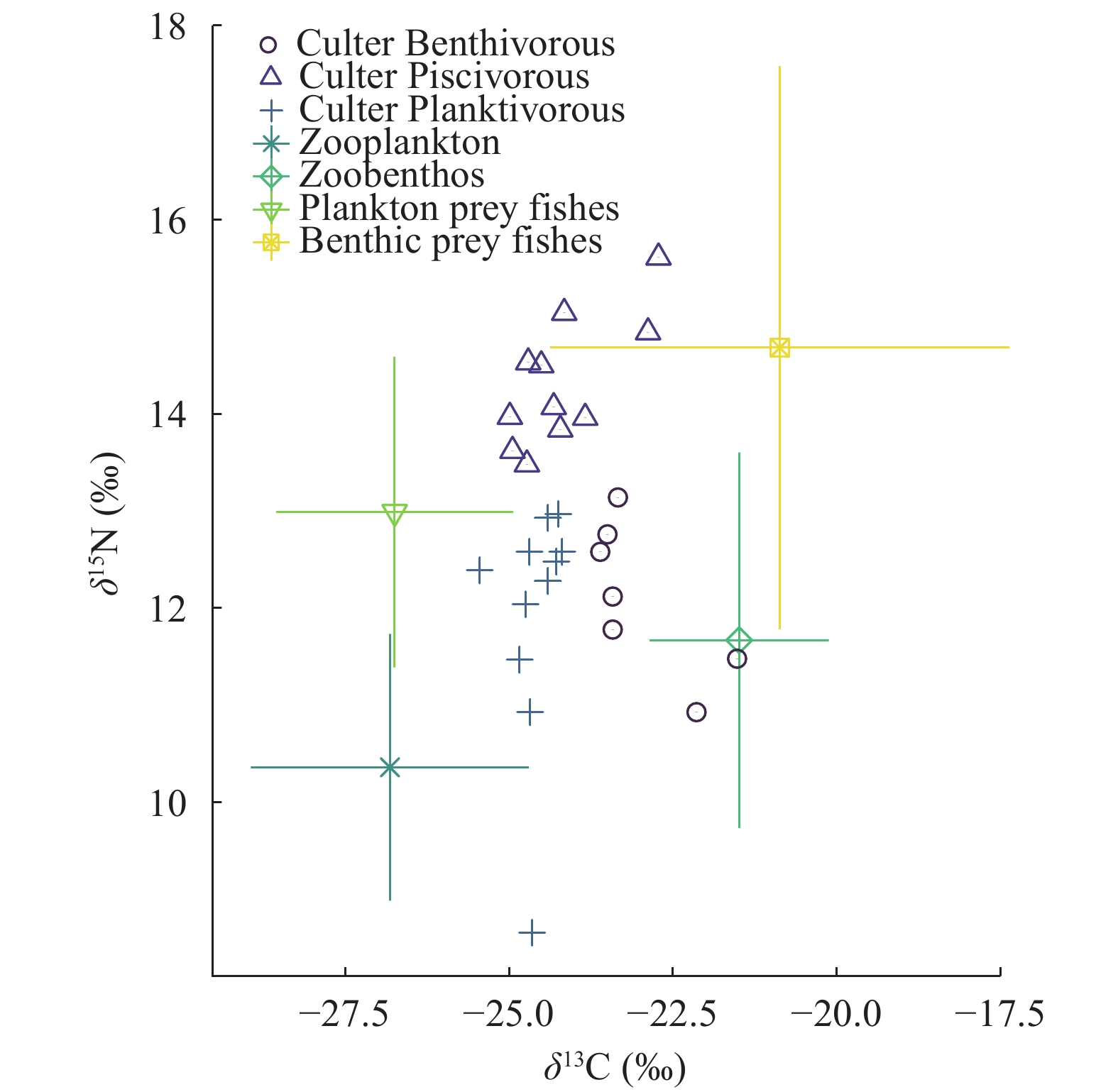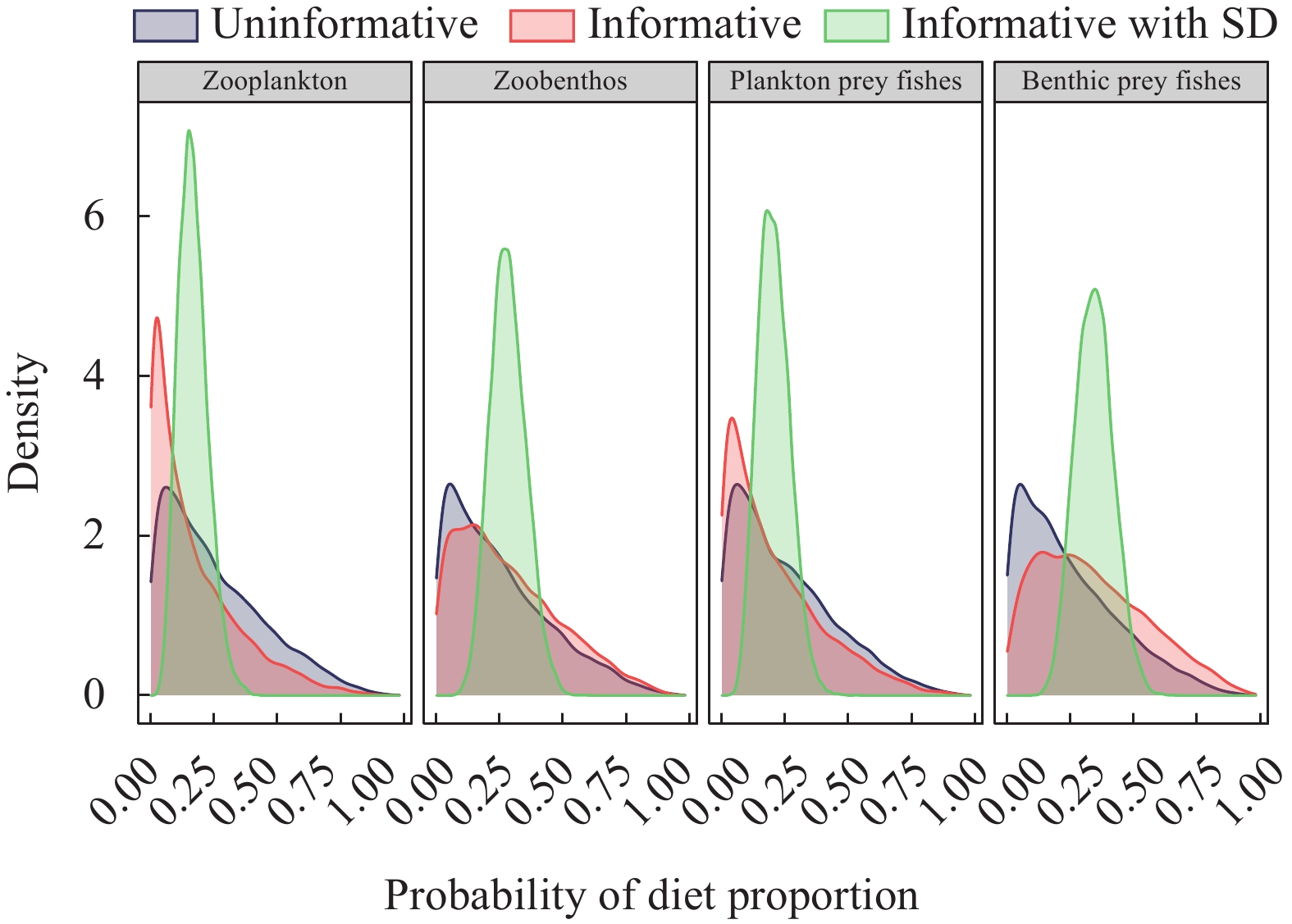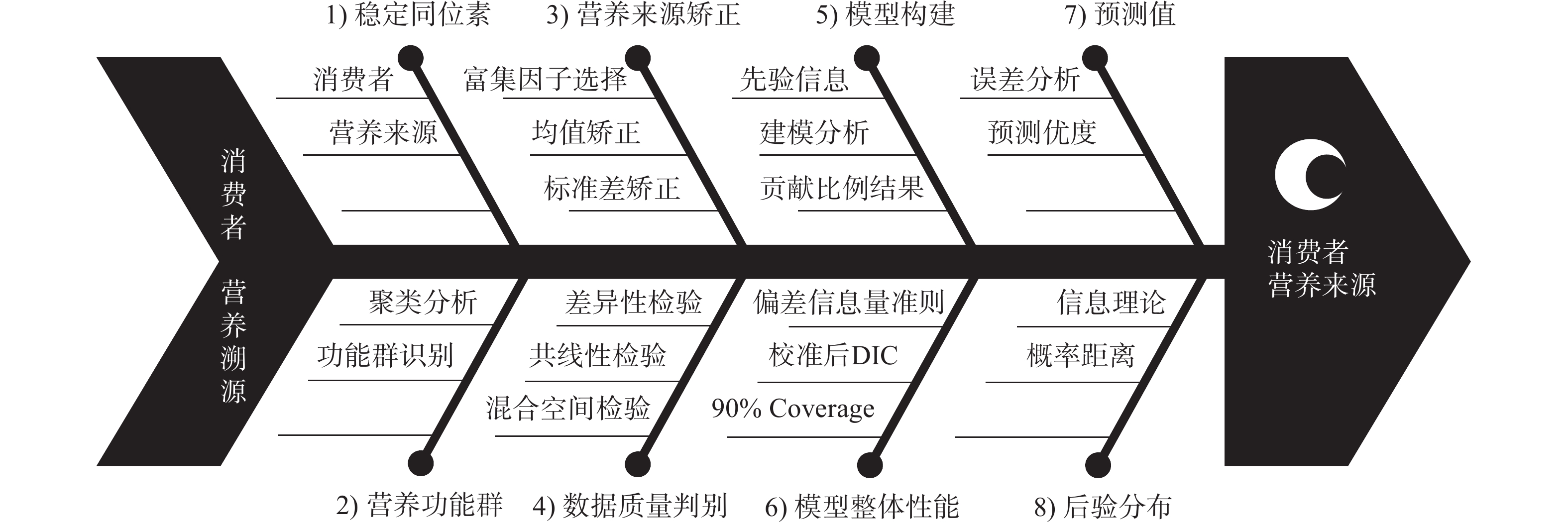STABLE ISOTOPE MIXING MODEL EVALUATION: QUANTIFYING THE QUALITY OF PREDICTIONS
-
摘要: 稳定同位素技术可以用于消费者营养溯源,以确定多种营养来源对消费者营养的贡献比重。因此,稳定同位素质量平衡混合模型已经是消费者营养溯源分析的必要方法之一。通常使用贝叶斯混合模型来估计不同营养来源的贡献;此类模型提供了每个营养来源对消费者的贡献比例的概率分布特征。然而,混合模型拟合结果的好坏,及其与实际生态学理论的匹配水平,是模型性能的重要评价内容。例如,模型在不能很好地解析营养来源贡献时,仍将返回默认先验结果,给模型解释带来困难。为直接避免同位素构建消费者营养溯源分析中的诸多技术问题,文章将综述在拟合和评估贝叶斯混合模型时遵循的最佳实践。因此,文章基于实测的同位素数据集(蒙古鲌Culter mongolicus mongolicus同位素数据集),通过识别消费者营养功能类群特征、改变营养来源先验信息特征,构建系列贝叶斯模型;通过比较模型总体性能、实测值与预测值差异,及先验信息和后验信息差异等多种模型性能评价方法,来描述模型性能评价的方法和过程。通过这些方法的综合运用,将进一步提高消费者营养溯源准确性,为更深刻地认识食物网规律提供科学支撑。Abstract: Stable isotope technique is of importance to study the ecology of food webs. Based on stable isotope mixing model of mass balance, stable isotope technology can be used for consumer nutrition traceability, that is, to determine the contribution of multiple sources of nutrition to the consumer. Stable isotope mixing model of mass balance has been one of the necessary methods for the traceability analysis of consumer nutrition sources. Bayesian mixing models are often used to estimate the contribution of different sources of nutrition. Such models provide probabilistic distribution characteristics of each nutrient source’s contribution to the consumer. However, the result of mixing model fitting and its matching level with the actual ecology theory are important evaluation contents of model performance. In order to ensure the accuracy of the modeling analysis, the modeling data must be corrected and verified first. Second, before data modeling, important prior information must be considered. Furthermore, the process of model selection and model evaluation for complete reproduction is a necessary condition for modeling, training, verification and evaluation. Model selection is to select the best model based on a set of model representations with different complexities and model evaluation is to evaluate the predicted error after selecting the model. According to the specific research, there are various evaluation indexes in practice, and the information loss of the relative “real model” is described respectively. Due to the unknown nature of the real model, these evaluations only reflect the relatively good performance of existing models in the construction process, so specific problems still need to be analyzed. Based on the measured isotope data set (isotope data set for Culter mongolicus mongolicus), this paper constructed a series of Bayesian models by identifying the characteristics of consumer nutrition functional groups and changing the a priori information characteristics of nutritional sources; and described the methods and processes of model performance evaluation by comparing the overall performance of the model, the difference between measured and predicted values, and the difference between prior and post-test information, so as to provide a model performance evaluation system for the application of stable isotope technology to carry out consumer nutrition traceability research. The fit quality of the model can be judged by the evaluation method, which focuses on the model’s ability to predict consumer isotope values. In addition, in view of the characteristics of the Bayesian mixing model, that is, if a priori information error is low, the mixed posterior distribution information of the model will converge to a priori information, and further evaluation will be based on information theory and probability distance statistical method to provide complementary assessment method for the quality of the output for the isotopic mixture model. The integrated use of these methods further improves the consumer nutrition source accuracy, and provides a scientific support for a more profound understanding of the food web laws. This paper reviews the best practices for fitting and evaluating Bayesian mixing model, and how to directly avoid many technical issues involved in isotope construction in consumer nutrition traceability analysis.
-
Keywords:
- Food webs /
- Stable isotopes /
- Bayesian models /
- Model performance /
- Consumer
-
-
图 1 种群内营养功能群的确定
A. K-means聚类与总体类内误差平方和百分比特征; B. 鱼类食性为主、浮游动物食性为主和底栖动物食性为主的3个功能类型
Figure 1. Within-population trophic functional groups
A. K-means cluster and percentage of total within sum of the squared errors; B. Three trophic functional groups, including piscivorous, planktivorous, and benthivorous
表 1 模型结果
Table 1 Model results
营养聚类Trophic cluster 营养来源Sources 平均值Mean 标准差SD 2.50% 50% 97.50% 鱼类食性Piscivorous Zooplankton 0.237 0.038 0.168 0.235 0.314 Zoobenthos 0.243 0.038 0.173 0.242 0.322 Plankton prey fishes 0.268 0.041 0.192 0.267 0.352 Benthic prey fishes 0.252 0.039 0.182 0.250 0.335 浮游动物食性Planktivorous Zooplankton 0.274 0.039 0.200 0.273 0.355 Zoobenthos 0.244 0.035 0.178 0.243 0.315 Plankton prey fishes 0.271 0.041 0.195 0.270 0.355 Benthic prey fishes 0.211 0.031 0.155 0.210 0.277 底栖动物食性Benthivorous Zooplankton 0.242 0.038 0.173 0.240 0.322 Zoobenthos 0.273 0.044 0.193 0.271 0.363 Plankton prey fishes 0.233 0.037 0.167 0.231 0.311 Benthic prey fishes 0.251 0.037 0.182 0.250 0.329 表 2 模型整体性能评价
Table 2 Model performance
营养聚类Trophic cluster 偏差信息量准则DIC 校准偏差信息量准则DICcor 参数有效数量pD 90% Coverage 模型样本数N 鱼类食性Piscivorous 80.12 49.18 2.83 100 11 浮游动物食性Planktivorous 44.43 28.39 3.87 100 10 底栖动物食性Benthivorous 44.43 41.44 2.99 100 7 表 3 基于预测值与测量值的模型评价方法
Table 3 Evaluation methods for the difference between model predicts and observations.
名称Name 全称Full name 缩写Abbreviation 公式Formula 性质Property 含义Meaning 参考文献Reference 最小预测误差 Minimum error Emin $E_{\rm{{min} } } = min\left( { { {\hat y}_i} - {y_i} } \right)$ 
(–∞,+∞) 预测值与真实值之间的最小偏差 [38] 最大预测误差 Maximum error Emax $E_{\rm{{max}}}= max\left( { { {\hat y}_i} - {y_i} } \right)$ 
(–∞,+∞) 预测值与真实值之间的最大偏差 [38] 均方误差 Mean squared error MSE ${\rm{MSE}}=\displaystyle\frac{1}{n}\sum _{i=1}^{n}{\left({\widehat{y} }_{i}-{y}_{i}\right)}^{2}$ 
[0,+∞) 衡量的是预测值与真实值之间的偏差,并且对数据中的异常值较为敏感。预测值与真实值完全吻合时等于0;误差越大,该值越大 [39] 根均方误差 Root mean square error RMSE ${\rm{RMSE}} = \sqrt {\displaystyle\frac{1}{n}\mathop \sum \limits_{i = 1}^n { {\left( { { {\hat y}_i} - {y_i} } \right)}^2} }$ 
[0,+∞) 同上。数量级上比MSE较直观,与观测值一致 [39] 标准根均方误差 Normalized root mean square error NRMSE ${\rm{NRMSE}}=\displaystyle\frac{\sqrt{\displaystyle\frac{1}{n}\sum _{i=1}^{n}{\left({\widehat{y} }_{i}-{y}_{i}\right)}^{2} } }{max\left({y}_{i}\right)-min\left({y}_{i}\right)}$ 
[0,1] 同上。可用于比较不同尺度观测值直接对模型预测的效果 [39] 平均绝对误差 Mean absolute error MAE ${\rm{MAE}}=\displaystyle\frac{1}{n}\sum _{i=1}^{n}\left|{\widehat{y} }_{i}-{y}_{i}\right|$ 
[0,+∞) 同上。更好地反映预测值误差的实际情况 [39] 平均绝对百分比误差 Mean absolute percentage error MAPE ${\rm{MAPE} }=\displaystyle\frac{100\text{%} }{n}\displaystyle\sum _{i=1}^{n}\left|\frac{ {\widehat{y} }_{i}-{y}_{i} }{ {y}_{i} }\right|$ 
[0,+∞) 预测值与真实值完全吻合时等于0%,大于100%则表示劣质模型分母部分为零时,不可用 [39] 对称平均绝对百分比误差 Symmetric mean absolute percentage error SMAPE ${\rm{SMAPE}}=\displaystyle\frac{100\text{%} }{n}\displaystyle\sum _{i=1}^{n}\frac{\left|{\widehat{y} }_{i}-{y}_{i}\right|}{\left(\left|{\widehat{y} }_{i}\right|-\left|{y}_{i}\right|\right)/2}$ 
[0,+∞) 同上 [39] 预测优度 Goodness of prediction G $G=1-\left[\displaystyle\sum _{i=1}^{n}{\left({\widehat{y} }_{i}-{y}_{i}\right)}^{2}/\sum _{i=1}^{n}{\left({y}_{i}-\overline{y}\right)}^{2}\right]$ 
[0,1] G值为1表示理想的预测。G值越接近1,模型的可靠性越高。G值为负表示该模型不太可靠 [40] R R R $R=\displaystyle\sum _{j=1}^{ {\delta }_{x} }\displaystyle\sum _{i=1}^{n}{\left(\frac{ {\widehat{y} }_{i,\;j} }{ {y}_{i,\;j} }-1\right)}^{2}$ 
[0,+∞) 预测值与真实值完全吻合时等于0;误差越大,该值越大 [40] 表 4 模型预测值与观测值差异评价
Table 4 Evaluation of the difference between model predicts and observations
营养聚类
Trophic cluster最大预测误差Emax 最小预测误差
Emin均方误差MSE 根均方误差
RMSE标准根均方误差NRMSE 平均绝对误差
MAE平均绝对百分比误差
MAPE对称平均绝对百分比误差SMAPE 预测优度Goodness-of-fit R 鱼类食性Piscivorous 1.195 –3.089 2.16 1.47 0.036 1.273 127.3 8.216 0.994 0.198 浮游动物食性Planktivorous 1.603 –0.492 0.547 0.74 0.019 0.594 59.4 3.377 0.998 0.043 底栖动物食性Benthivorous 1.602 –2.261 0.938 0.969 0.026 0.732 73.2 4.513 0.997 0.055 表 5 主要信息理论度量与统计
Table 5 The important information theory measures and statistics
名称Name 全称Full Name 缩写Abbrevaition 公式Formula 含义Meaning 参考文献Reference 信息熵 Shannon Entropy
或Information EntropyH(x) $H(x)=-\displaystyle\sum _{x}p(x)\mathrm{log}p(x)\\=-\displaystyle\sum _{i=1}^{n}p\left({x}_{i}\right)\mathrm{log}p\left({x}_{i}\right)$ 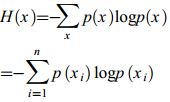
是一个事件总的信息量,是每一种可能的情况的信息量乘以它们发生的概率,即所有可能发生事件所带来的信息量的期望 [43, 44] 联合熵 Joint Entropy H(X, Y) $\begin{array}{c}H(X,Y)=-\displaystyle\sum _{x,\;y}p(x,\;y)\mathrm{log}p(x,y)\\ =-\displaystyle\sum _{i=1}^{n}\displaystyle\sum _{j=1}^{m}p\left({x}_{i},\;{y}_{i}\right)\mathrm{log}p\left({x}_{i},\;{y}_{j}\right)\end{array}$ 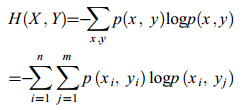
同上,拓展至多维分布。H(X) 和H(Y) 的并集是联合熵 H(X, Y) [43] 条件熵 Conditional Entropy H(Y|X) $H\left( {Y|X} \right) = H(X,Y) - H(X)$ 
描述X和Y所需的信息是描述X自己所需的信息,加上给定X的条件下具体化Y所需的额外信息 [43] 互信息 Mutual Information I(X, Y) $\begin{array}{*{20}{c} } {I(X,Y) = H(X) - H(X|Y)} \\ {= H(Y) - H(Y|X)} \\ { = H(X) + H(Y) - H(Y|X)} \\ { = H(X,Y) - H(X|Y) - H(Y|X)} \end{array}$ 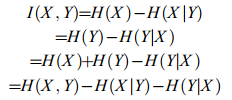
亦成为转移信息(Transinformation),
是两个随机变量间相互依赖性的量度。
H(X) 和 H(Y) 的交集是互信息 I(X, Y)[43] 交叉熵 Cross Entropy Hcross ${H}_{{\rm{cross}}}(p,q)=\displaystyle\sum _{x}p(x)\mathrm{log}\displaystyle\frac{1}{q(x)}\\=-\sum _{x}p(x)\mathrm{log}q(x)$ 
交叉熵用来衡量在给定X下,使用Y策略消除系统的不确定性所需要付出成本的大小。值越小,两个概率分布就越接近 [43] 相对熵- KL 散度 Kullback–
Leibler divergence, KLDDKL ${D}_{{\rm{KL}}}(p\parallel q)=\displaystyle\sum _{x}p(x)\mathrm{log}\displaystyle\frac{p(x)}{q(x)}\\={E}_{p(x)}\mathrm{log}\displaystyle\frac{p(x)}{q(x)}$ 
${D_{{\rm{KL}}} }(p\parallel q) = {H_{cross} }(p,\;q) - H(p)$ 
衡量两个概率分布之间的差异“距离”,反映了用分布q的最佳信息传递方式来传达分布p,比用分布p自己的最佳信息传递方式来传达分布p,平均多耗费的信息长度。KL散度是用于衡量分布之间的差异程度的,又称信息增益(Information gain) [43] 相对熵 –JS散度 Jensen-Shannon divergence DJS ${D_{ {\rm{JS} } } }(p\parallel q) = \displaystyle\frac{1}{2}{D_{KL} }\left( {p\parallel \frac{ {p + q} }{2} } \right) + \\\displaystyle\frac{1}{2}{D_{KL} }\left( {q\parallel \frac{ {p + q} }{2} } \right)$ 
KL 散度的缺点是它不是距离、不对称。因此引入JS散度的概念,是 KL 散度的变形。JS散度是对称且非负的, $ JSD(P\parallel Q) = JSD(Q\parallel P) $ 。
$JSD = 0$ , if and only if
$P = Q$ 
[43] 相对熵 –GJS散度 Generalized Jensen-Shannon Divergence DGJS $gJS{D}_{ {\text{π} }_{1},\cdots ,{\text{π} }_{n} }\left({P}_{1},\cdots ,{P}_{n}\right)=\\H\left(\displaystyle\sum _{i=1}^{n}{\text{π} }_{i}\ast {P}_{i}\right)-\displaystyle\sum _{i=1}^{n}{\text{π} }_{i}\ast H\left({P}_{i}\right)$ 
同上,拓展至多维分布 [43] 表 7 概率分布相似度评价的几种距离法
Table 7 Some distance methods to evaluate similarity of probabilistic distribution
全称Full Name 缩写Abbreviation 公式Formula 含义Meaning 参考文献Reference 海灵格距离
Hellinger distanceHD ${H^2}(P,\;Q) = \displaystyle\frac{1}{2}\int {(\sqrt {dP} - \sqrt {dQ} )^2}$ 
海灵格距离计算先验和后验之间的无单位差。这样做,它获得了一些可解释性,因为它的最大值是1。海灵格距离对于确定准确描述摄食者食性组成所需的样本量非常有用 [45] 最大平均差异
Maximum mean discrepancyMMD ${\rm{MMD}}[ℱ,\;X,\;Y]=\\{\left[\displaystyle\frac{1}{ {m}^{2} }\sum _{i,j=1}^{m}k\left({x}_{i},\;{x}_{j}\right)-\frac{2}{mn}\sum _{i,j=1}^{m,n}k\left({x}_{i},\;{y}_{j}\right)+\frac{1}{ {n}^{2} }\sum _{i,j=1}^{n}k\left({y}_{i},\;{y}_{j}\right)\right]}^{\frac{1}{2} }$ 
基于两个分布的样本,通过寻找在样本空间上的映射函数K,求不同分布的样本在K上的函数值的均值,通过把两个均值作差可以得到两个分布对应于K的mean discrepancy。寻找一个K使得这个mean discrepancy有最大值,就得到了MMD。最后取MMD作为检验统计量(test statistic),从而判断两个分布是否相同。如果这个值足够小,就认为两个分布相同,否则就认为它们不相同。更加简单的理解就是:求两堆数据在高维空间中的均值的距离 [46] 瓦瑟斯坦距离Wasserstein distance WD ${\rm{WORK}}(P,\;Q,\;F)=\displaystyle\sum _{i=1}^{m}\sum _{j=1}^{n}{d}_{ij}{f}_{ij}^{}$ 
衡量了把数据从分布p“移动成”分布q时所需要移动的平均距离的最小值,不仅给出了距离的度量,而且给出如何把一个分布变换为另一分布的转移方案 [47] 表 6 先验信息与后验信息的信息理论统计结果
Table 6 The important information theory measures and statistics
信息理论
Infomation theory营养来源
Source先验信息
Prior. information鱼类食性
Piscivorous浮游动物食性
Planktivorous底栖动物食性
Benthivorous信息熵 Shannon’s Entropy Zooplankton 12.86205362 14.2564454 14.2564497 14.2563905 Zoobenthos 12.85236519 14.2560339 14.2561267 14.2560087 Plankton prey fishes 12.84968762 14.2562204 14.2562049 14.2562201 Benthic prey fishes 12.85681723 14.2560032 14.2559697 14.2560624 相对熵- KL 散度 Kullback-Leibler Divergence Zooplankton — –0.1795993 –0.1789568 –0.1786544 Zoobenthos — –0.1642057 –0.1642421 –0.1639883 Plankton prey fishes — –0.1654721 –0.1650742 –0.1654557 Benthic prey fishes — –0.1682989 –0.1680717 –0.1677031 相对熵 –JS散度 Jensen-Shannon Divergence Zooplankton — 0.1387041 0.1391457 0.1390174 Zoobenthos — 0.1409801 0.1410425 0.1412026 Plankton prey fishes — 0.1412871 0.141212 0.1412597 Benthic prey fishes — 0.1400291 0.140179 0.1399777 相对熵 –GJS散度 Generalized Jensen-Shannon
DivergenceZooplankton — 0.1387041 0.1391457 0.1390174 Zoobenthos — 0.1409801 0.1410425 0.1412026 Plankton prey fishes — 0.1412871 0.141212 0.1412597 Benthic prey fishes — 0.1400291 0.140179 0.1399777 交叉熵 Cross Entropy Zooplankton — 12.6824543 12.6830969 12.6833992 Zoobenthos — 12.6881595 12.6881231 12.6883769 Plankton prey fishes — 12.6842155 12.6846134 12.6842319 Benthic prey fishes — 12.6885184 12.6887455 12.6891141 互信息 Mutual Information Zooplankton — 12.8620536 12.8620536 12.8620536 Zoobenthos — 12.8523652 12.8523652 12.8523652 Plankton prey fishes — 12.8496876 12.8496876 12.8496876 Benthic prey fishes — 12.8568172 12.8568172 12.8568172 -
[1] Vander Zanden M J V, Rasmussen J B. Variation in δ15N and δ13C trophic fractionation: Implications for aquatic food web studies [J]. Limnology and Oceanography, 2001, 46(8): 2061-2066.
[2] Boecklen W J, Yarnes C T, Cook B A, et al. On the use of stable isotopes in trophic ecology [J]. Annual Review of Ecology, Evolution and Systematics, 2011, 42(1): 411-440.
[3] Xu J, Xie P. Studies on the food web structure of Lake Donghu using stable carbon and nitrogen isotope ratios [J]. Journal of Freshwater Ecology, 2004, 19(4): 645-650.
[4] 徐军, 周琼, 曾庆飞, 等. 碳、氮稳定同位素技术及其在水域生态学研究中的应用 [M]//段昌群. 生态科学进展. 第5卷. 北京: 高等教育出版社, 2010: 35-80. Xu J, Zhou Q, Zeng Q F, et al. Stable Carbon and Nitrogen Isotopes in Aquatic Ecology: Theory and Applications [M]//Duan C Q. Advances in Ecological Sciences Vol. 5. Beijing: Higher Education Press, 2010: 35-80.
[5] Xu J, Xie P, Zhang M, et al. Icefish (Salangidae) as an indicator of anthropogenic pollution in freshwater systems using nitrogen isotope analysis [J]. Bulletin of Environmental Contamination and Toxicology, 2007, 79(3): 323-326.
[6] Phillips D L, Koch P L. Incorporating concentration dependence in stable isotope mixing models [J]. Oecologia, 2002, 130(1): 114-125.
[7] Xu J, Zhang M, Xie P. Size-related shifts in reliance on benthic and pelagic food webs by lake anchovy [J]. Ecoscience, 2007, 14(2): 170-177.
[8] Xu J, Zhang M, Xie P. Stable isotope changes in freshwater shrimps (Exopalaemon modestus and Macrobrachium nipponensis): trophic pattern implications [J]. Hydrobiologia, 2008, 605(1): 45-54.
[9] Phillips D L, Inger R, Bearhop S, et al. Best practices for use of stable isotope mixing models in food-web studies [J]. Canadian Journal of Zoology, 2014, 92(10): 823-835.
[10] Layman C A, Araujo M S, Boucek R, et al. Applying stable isotopes to examine food‐web structure: an overview of analytical tools [J]. Biological Reviews, 2012, 87(3): 545-562.
[11] Swan G J F, Bearhop S, Redpath S M, et al. Evaluating Bayesian stable isotope mixing models of wild animal diet and the effects of trophic discrimination factors and informative priors [J]. Methods in Ecology and Evolution, 2020, 11(1): 139-149.
[12] 李斌, 王志坚, 金丽, 等. 蒙古鲌食性转变的稳定性同位素研究 [J]. 水产学报, 2011, 35(9): 1419-1425. Li B, Wang Z J, Jin L, et al. Study on diet shift of Erythroulter mongolicus mongolicus with stable isotope technology [J]. Journal of Fisheries of China, 2011, 35(9): 1419-1425.
[13] 徐军, 王玉玉, 王康, 等. 水域生态学中生物稳定同位素样品采集、处理与保存 [J]. 水生生物学报, 2020, 44(5): 989-997. Xu J, Wang Y Y, Wang K, et al. Protocols for sample collection, pretreatment and preservation of aquatic organisms in stable isotope ecology [J]. Acta Hydrobiologica Sinica, 2020, 44(5): 989-997.
[14] Tan P N, Steinbach M, Karpatne A, et al. Introduction to Data Mining [M]. Boston: Pearson Addison Wesley, 2006: 534-553.
[15] Kanungo T, Mount D M, Netanyahu N S, et al. An efficient k-means clustering algorithm: analysis and implementation [J]. IEEE Transactions on Pattern Analysis Machine Intelligence, 2002, 24(7): 881-892.
[16] Xu J, Wen Z, Ke Z, et al. Contrasting energy pathways at the community level as a consequence of regime shifts [J]. Oecologia, 2014, 175(1): 231-241.
[17] Xu J, Zhang H, Cai Y, et al. Optimal response to habitat linkage of local fish diversity and mean trophic level [J]. Limnology and Oceanography, 2016, 61(4): 1438-1448.
[18] Xu J, Zhang M. Primary consumers as bioindicator of nitrogen pollution in lake planktonic and benthic food webs [J]. Ecological Indicators, 2012, 14(1): 189-196.
[19] 徐军. 应用碳、氮稳定性同位素探讨淡水湖泊的食物网结构和营养级关系 [D]. 武汉: 中国科学院水生生物研究所, 2005: 63-72. Xu J. Ecological studies on the food webs tructures and trophic relationships of freshwater lakes in China using stable carbon and nitrogen isotopes [D]. Wuhan: Institute of Hydrobiology, Chinese Academy of Scineces, 2005: 63-72.
[20] 徐军, 张敏, 谢平. 氮稳定同位素基准的可变性及对营养级评价的影响 [J]. 湖泊科学, 2010, 22(1): 8-20. Xu J, Zhang M, Xie P. Variability of stable nitrogen isotopic baselines and its consequence for trophic modeling [J]. Journal of Lake Sciences, 2010, 22(1): 8-20.
[21] Bond A L, Diamond A W. Recent Bayesian stable‐isotope mixing models are highly sensitive to variation in discrimination factors [J]. Ecological Applications, 2011, 21(4): 1017-1023.
[22] Rio C M N D, Wolf N, Carleton S A, et al. Isotopic ecology ten years after a call for more laboratory experiments [J]. Biological Reviews, 2009, 84(1): 91-111.
[23] Kurle C M, Koch P L, Tershy B R, et al. The effects of sex, tissue type, and dietary components on stable isotope discrimination factors (Δ13C and Δ15N) in mammalian omnivores [J]. Isotopes in Environmental Health Studies, 2014, 50(3): 307-321.
[24] Fry B. Stable Isotope Ecology [M]. New York: Springer, 2006: 1-308.
[25] Post D M. Using stable isotopes to estimate trophic position: models, methods, and assumptions [J]. Ecology, 2002, 83(3): 703-718.
[26] Szpak P, Metcalfe J Z, Macdonald R A. Best practices for calibrating and reporting stable isotope measurements in archaeology [J]. Journal of Archaeological Science: Reports, 2017(13): 609-616.
[27] Hopkins J B, Ferguson J M, Tyers D B, et al. Selecting the best stable isotope mixing model to estimate grizzly bear diets in the Greater Yellowstone Ecosystem [J]. PLoS One, 2017, 12(5): e0174903.
[28] Smith J A, Mazumder D, Suthers I M, et al. To fit or not to fit: Evaluating stable isotope mixing models using simulated mixing polygons [J]. Methods in Ecology and Evolution, 2013, 4(7): 612-618.
[29] Fry B. Alternative approaches for solving underdetermined isotope mixing problems [J]. Marine Ecology Progress Series, 2013(472): 1-13.
[30] Mccarthy M A, Masters P. Profiting from prior information in Bayesian analyses of ecological data [J]. Journal of Applied Ecology, 2005, 42(6): 1012-1019.
[31] Kuhnert P M, Martin T G, Griffiths S P. A guide to eliciting and using expert knowledge in Bayesian ecological models [J]. Ecology Letters, 2010, 13(7): 900-914.
[32] Choy S L, O’leary R, Mengersen K. Elicitation by design in ecology: using expert opinion to inform priors for Bayesian statistical models [J]. Journal of Ecology, 2009, 90(1): 265-277.
[33] Votier S C, Bearhop S, Maccormick A, et al. Assessing the diet of great skuas, Catharacta skua, using five different techniques [J]. Polar Biology, 2003, 26(1): 20-26.
[34] Chiaradia A, Forero M G, Mcinnes J C, et al. Searching for the true diet of marine predators: Incorporating bayesian priors into stable isotope mixing models [J]. PLoS One, 2014, 9(3): e92665.
[35] Parnell A. Simmr: a stable isotope mixing model [J]. https://github.com/andrewcparnell/simmr, 2016.
[36] Meyer R. Deviance Information Criterion (DIC) [M]//Balakrishnan N, Colton T, Everitt B, et al. (Eds.), Wiley StatsRef: Statistics Reference Online: Wiley, 2016: 1-6.
[37] Brown C J, Brett M T, Adame M F, et al. Quantifying learning in biotracer studies [J]. Oecologia, 2018, 187(3): 597-608.
[38] Li J, Heap A D. A review of comparative studies of spatial interpolation methods in environmental sciences: Performance and impact factors [J]. Ecological Informatics, 2011, 6(3-4): 228-241.
[39] Shcherbakov M, Brebels A, Cshcherbakova N L, et al. A survey of forecast error measures [J]. World Applied Sciences Journal, 2013, 24(24): 171-176.
[40] Cramer V A, Thorburn P J, Fraser G W. Transpiration and groundwater uptake from farm forest plots of Casuarina glauca and Eucalyptus camaldulensis in saline areas of southeast Queensland, Australia [J]. Agricultural Water Management, 1999, 39(23): 187-204.
[41] Parnell A C, Phillips D L, Bearhop S, et al. Bayesian stable isotope mixing models [J]. Environmetrics, 2013, 24(6): 387-399.
[42] Ehleringer J R, Dawson T E. Water uptake by plants: perspectives from stable isotope composition [J]. Plant, Cell & Environment, 1992, 15(9): 1073-1082.
[43] Kullback S. Information Theory and Statistics [M]. London: Chapman and Hall, 1959: 36-69.
[44] Shannon C E. A mathematical theory of communication [J]. Bell System Technical Journal, 1948, 27(3): 379-423.
[45] Gibbs A L, Su F E. On Choosing and bounding probability metrics [J]. International Statistical Review, 2002, 70(3): 419-435.
[46] Sriperumbudur B K, Fukumizu K, Gretton A, et al. Non-parametric Estimation of Integral Probability Metrics [C]. International Symposium on Information Theory. 2010: 1428-1432.
[47] Panaretos V M, Zemel Y. Statistical Aspects of Wasserstein Distances [J]. Annual Review of Statistics and lts Application, 2019, 6(1): 405-431.
[48] Egozcue J J, Pawlowsky-Glahn V, Mateu-Figueras G, et al. Isometric logratio transformations for compositional data analysis [J]. Mathematical Geology, 2003, 35(3): 279-300.
[49] Kailath T. The Divergence and bhattacharyya distance measures in signal selection [J]. IEEE Transactions on Communications, 1967, 15(1): 52-60.
[50] Mccann K S, Rasmussen J B, Umbanhowar J. The dynamics of spatially coupled food webs [J]. Ecology Letters, 2005, 8(5): 513-523.
-
期刊类型引用(16)
1. 贾滢暄,张树林,张达娟,戴伟,毕相东. 磷恢复对磷饥饿铜绿微囊藻光合色素和部分抗氧化酶活性的影响. 中国农业科技导报. 2024(01): 70-77 .  百度学术
百度学术
2. 凌晨,付发武,张翠霞,雷灵逸,金书言,刘小芳,张守庆,鲁翠翠. 不同氮磷营养条件对中肋骨条藻和球等鞭金藻生长及元素组成的影响. 中国海洋大学学报(自然科学版). 2024(08): 63-73 .  百度学术
百度学术
3. 张萍,陆家昌,李朗,石天应,赖俊翔,庄军莲,李杰. 硅壳和细胞内含物对硅藻沉降速率的影响. 海洋环境科学. 2023(06): 927-934 .  百度学术
百度学术
4. 卫燕云,金鹏,江莹莹,夏建荣. 海洋酸化与磷浓度变化对龙须菜光合作用和ATPase活性的影响. 生态科学. 2021(01): 1-8 .  百度学术
百度学术
5. 陈宁,何佳昕,孙晓莉,刘妍,范亚文. 硝态氮与无机磷浓度及其比例对簇生舟形藻生长生理及细胞形态的影响. 西北植物学报. 2021(04): 615-626 .  百度学术
百度学术
6. 朱文娜,龚一富,郭芮栋,杨雨,蔡嘉硕,王何瑜,汪如. 磷限制对三角褐指藻脂质含量及相关基因表达的影响. 中国粮油学报. 2021(07): 93-99 .  百度学术
百度学术
7. 陈若莹,徐润洁,龚一富,刘芳,付旭,章丽,王何瑜,石慧. 氮元素对三角褐指藻岩藻黄素和油脂合成关键酶基因表达与代谢合成的影响. 核农学报. 2019(09): 1734-1741 .  百度学术
百度学术
8. 司冉冉,关万春,蔡景波,陈少波. 氮源对塔玛亚历山大藻生长和毒性的影响. 生态学杂志. 2017(10): 2880-2885 .  百度学术
百度学术
9. 石琦,梅洪,张成军,黄建,吴红艳. 缺磷和高光对集球藻光合生理和油脂积累的影响. 植物科学学报. 2017(02): 291-298 .  百度学术
百度学术
10. 杨坤,卢文轩,李静. 小球藻磷吸收的初步研究. 安全与环境学报. 2016(05): 216-220 .  百度学术
百度学术
11. 刘俊鹏,屈亮,刘信勇,高宏昭,王彤彤. 不同营养条件对地表水藻类生长的影响. 环境工程. 2016(S1): 407-410 .  百度学术
百度学术
12. 徐兴莲,宋熙坤,岳瑞,张思思,王雅琴,吴红艳. 氮限制对硅藻三角褐指藻光系统Ⅱ光化学反应的影响. 生态学杂志. 2016(01): 183-188 .  百度学术
百度学术
13. 李磊,关万春,陈少波,谢起浪. 水体N/P对塔玛亚历山大藻响应紫外辐射的影响. 生态学杂志. 2016(02): 395-400 .  百度学术
百度学术
14. 张聪慧,朱淮民. 日本血吸虫潜在药物靶点β-碳酸酐酶的表达与鉴定. 中国血吸虫病防治杂志. 2016(02): 161-166 .  百度学术
百度学术
15. 王越,沈盎绿,赵世烨,朱礼鑫,宋淑贞,李道季. pH对米氏凯伦藻(Karenia mikimotoi)种群生长、营养吸收及无机碳亲和力的影响. 海洋环境科学. 2015(04): 488-493 .  百度学术
百度学术
16. 曾晓鹏,夏建荣. 光强对两种硅藻光合作用、碳酸酐酶和RubisCO活性的影响. 水生生物学报. 2015(02): 368-374 .  本站查看
本站查看
其他类型引用(11)



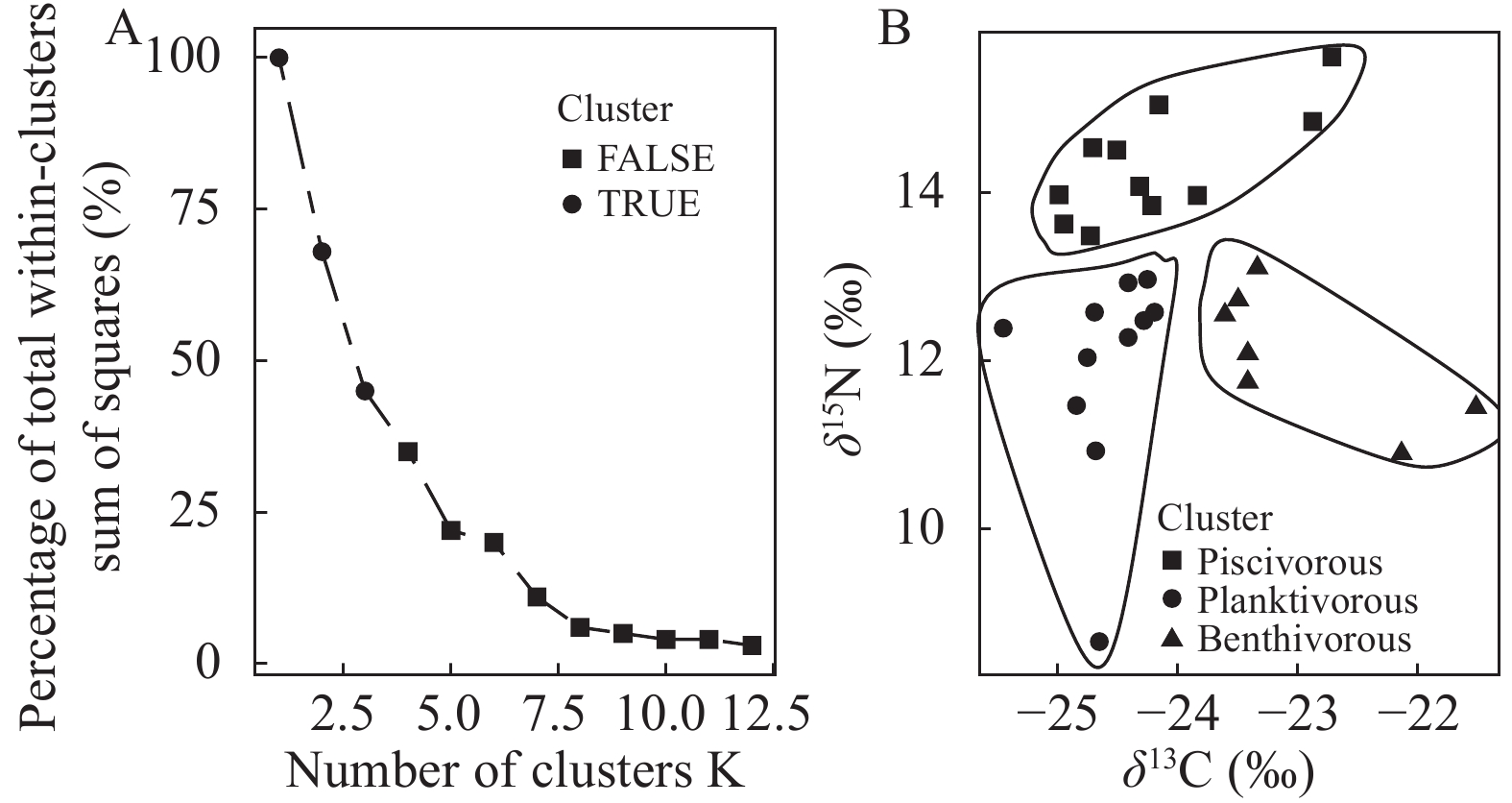
 下载:
下载:
